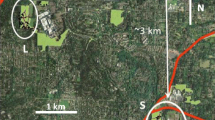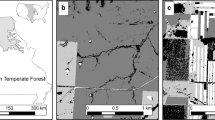Abstract
A comprehensive understanding of how natural and anthropogenic variation in habitat influences populations requires long-term information on how such variation affects survival and dispersal throughout the annual cycle. Gray jays Perisoreus canadensis are widespread boreal resident passerines that use cached food to survive over the winter and to begin breeding during the late winter. Using multistate capture-recapture analysis, we examined apparent survival and dispersal in relation to habitat quality in a gray jay population over 34 years (1977–2010). Prior evidence suggests that natural variation in habitat quality is driven by the proportion of conifers on territories because of their superior ability to preserve cached food. Although neither adults (>1 year) nor juveniles (<1 year) had higher survival rates on high-conifer territories, both age classes were less likely to leave high-conifer territories and, when they did move, were more likely to disperse to high-conifer territories. In contrast, survival rates were lower on territories that were adjacent to a major highway compared to territories that did not border the highway but there was no evidence for directional dispersal towards or away from highway territories. Our results support the notion that natural variation in habitat quality is driven by the proportion of coniferous trees on territories and provide the first evidence that high-mortality highway habitats can act as an equal-preference ecological trap for birds. Reproductive success, as shown in a previous study, but not survival, is sensitive to natural variation in habitat quality, suggesting that gray jays, despite living in harsh winter conditions, likely favor the allocation of limited resources towards self-maintenance over reproduction.


Similar content being viewed by others
References
Boehning-Gaese K, Halbe B, Lemoine N, Oberrath R (2000) Factors influencing the clutch size, number of broods and annual fecundity of North American and European land birds. Evol Ecol Res 2:823–839
Bowler DE, Benton TG (2005) Causes and consequences of animal dispersal strategies: relating individual behaviour to spatial dynamics. Biol Rev 80:205–225
Brownie C, Hines JE, Nichols JD, Pollock KH, Hestbeck JB (1993) Capture–recapture studies for multiple strata including non-Markovian transitions. Biometrics 49:1173–1187
Burnham KP, Anderson DR (2002) Model selection and multimodel inference: a practical information-theoretic approach, 2nd edn. Springer, New York
Cardillo M (2002) The life-history basis of latitudinal diversity gradients: how do species traits vary from the poles to the equator. J Anim Ecol 71:79–87
McGuire AD, Chapin III, FS, Wirth C, Apps MJ, Bhatti JS, Callaghan T, Christensen TR, Clein JS, Fukuda M, Maximov T, Omuchin A, Shvidenko A, Vaganov E (2007) Responses of high latitude ecosystems to global change: potential consequences for climate system. In: Canadell, Pataki DE (eds) Terrestrial ecosystems in a changing World, pp 297–310. Springer, New York
Clobert J, Danchin E, Dhondt AA, Nichols JD (2001) Dispersal. Oxford University Press, Oxford
Coffin AW (2007) From roadkill to road ecology: a review of the ecological effects of roads. J Trans Geogr 15:396–406
Develey PF, Stouffer PC (2001) Effects of roads on movements by understory birds in mixed-species flocks in central Amazonian Brazil. Conserv Biol 15:1416–1422
Forman RTT, Alexander LE (1998) Roads and their major ecological effects. Annu Rev Ecol Syst 209:207–231
Fretwell SD (1972) Populations in a seasonal environment. Princeton University Press, Princeton
Hestbeck JB (1995) Bias in transition-specific survival and movement probabilities estimates using capture–recapture data. J Appl Stat 22:737–750
Hestbeck JB, Nichols JD, Malecki RA (1991) Estimates of movement and site fidelity using mark-resight data of wintering Canada Geese. Ecology 72:523–533
Jetz W, Sekercioglu CH, Boehning-Gaese K (2008) The worldwide variation in avian clutch size across species and space. PLoS Biol 6:e303
Krebs CJ, Boutin S, Boonstra R (2001) Ecosystem dynamics of the boreal forest: the Kluane project. Oxford University Press, New York
Lebreton J-D, Pradel R (2002) Multistate recapture models: modelling incomplete individual histories. J Appl Stat 29:353–369
Lebreton J-D, Burnham KP, Clobert J, Anderson DR (1992) Modeling survival and testing biological hypotheses using marked animals: a unified approach with case studies. Ecol Monogr 62:67–118
Martin TE (1996) Life history variation in tropical and south temperate birds: what do we really know? J Avian Biol 27:263–272
Mazerolle DF, Hobson KA (2003) Do ovenbirds (Seiurus aurocapillus) avoid boreal forest edges? A spatiotemporal analysis in an agricultural landscape. Auk 120:152–162
Mumme RL, Schoech SJ, Woolfenden GE, Fitzpatrick JW (2000) Life and death in the fast lane: demographic consequences of road mortality in the Florida scrub-jay. Conserv Biol 14:501–512
Norris DR, Stutchbury BJM (2001) Extraterritorial movements of a forest songbird in a fragmented landscape. Conserv Biol 15:729–736
Pyle P (1997) Identification Guide to North American Birds, part 1. Slate Creek Press, Bolinas
Redmond LJ, Murphy MT (2011) Multistate mark-recapture analysis reveals no effect of blood sampling on survival and recapture of eastern kingbirds (Tyrannus tyrannus). Auk 128:514–521
Ricklefs RE (1997) Demography of new world populations of thrushes (Turdus spp.). Ecol Monogr 67:23–43
Robertson BA, Hutto RL (2006) A framework for understanding ecological traps and an evaluation of existing evidence. Ecology 87:1075–1085
Sanz JJ (2001) Latitudinal variation in female local return rate in the philopatric pied flycatcher (Ficedula hypoleuca). Auk 118:539–543
Schlaepfer MA, Runge MC, Sherman PW (2002) Ecological and evolutionary traps. Trends Ecol Evol 17:474–480
Sillett TS, Holmes RT, Sherry TW (2000) Impacts of a global climate cycle on populations dynamics of a migratory songbird. Science 288:2040–2042
Soja AM, Tchebakova NM, French NHF, Flannigan MD, Shugart HH, Stocks BJ, Sukhinin AI, Parfenova EE, Chapin FS III, Stackhouse PW Jr (2007) Climate-induced boreal forest change: predictions versus current observations. Global Planet Change 56:274–296
Strickland D (1969) Écologie, comportement social et nidification du geai gris (Perisoreus canadensis). M.Sc. Thesis. Université de Montréal, Montréal
Strickland D (1991) Juvenile dispersal in gray jays: dominant brood member expels siblings from natal territory. Can J Zool 69:2935–2945
Strickland D (1992) Finding (and watching) gray jays in Algonquin Park. Ont Birds 10:1–10
Strickland D (2003) The unsuspected valley drowners. In: The Raven: Algonquin Park newsletter, vol 44, no. 10. Friends of Algonquin Park, Algonquin Park, ON
Strickland D, Ouellet H (2011) gray jay (Perisoreus canadensis). In: Poole A (ed) The birds of North America. Cornell Lab of Ornithology, Ithaca
Strickland D, Kielstra B, Norris DR (2011) Experimental evidence for a novel mechanism driving variation in habitat quality in a food-caching bird. Oecologia 167:943–950
Vander Wall SB (1990) Food hoarding in animals. University of Chicago Press, Chicago
Waite TA, Strickland D (2006) Climate change and the demographic demise of a hoarding bird living on the edge. Proc R Soc Lond B 273:2809–2813
Welch DW, Rechisky EL, Melnychuk MC, Porter AD, Walters CJ, Clements S, Clemens BJ, McKinley RS, Schreck C (2008) Survival of migrating salmon smolts in large rivers with and without damns. PLoS Biol 6:e265
White GC, Burnham KP (1999) Program MARK: survival estimation from populations of marked animals. Bird Study 46:S120–S139
Acknowledgments
We thank the dozens of volunteers who helped with finding nests, as well as banding adult and nestling gray jays over the past 34 years, in particular S. and M. Strickland, R. and D. Tozer, G. and D. Hanes, W. and S. Calvert, A. Newman, and the late M. Pageot. R. Hawkins and P. Palbiski provided key logistical support. This work was supported by the Friends of Algonquin Park (D. S.), the Natural Sciences and Engineering Research Council of Canada (D. R. N., D. T. T. F.), and a University Research Chair to D.R.N.
Author information
Authors and Affiliations
Corresponding author
Additional information
Communicated by Ola Olsson.
Electronic supplementary material
Below is the link to the electronic supplementary material.
Rights and permissions
About this article
Cite this article
Norris, D.R., Flockhart, D.T.T. & Strickland, D. Contrasting patterns of survival and dispersal in multiple habitats reveal an ecological trap in a food-caching bird. Oecologia 173, 827–835 (2013). https://doi.org/10.1007/s00442-013-2680-1
Received:
Accepted:
Published:
Issue Date:
DOI: https://doi.org/10.1007/s00442-013-2680-1




